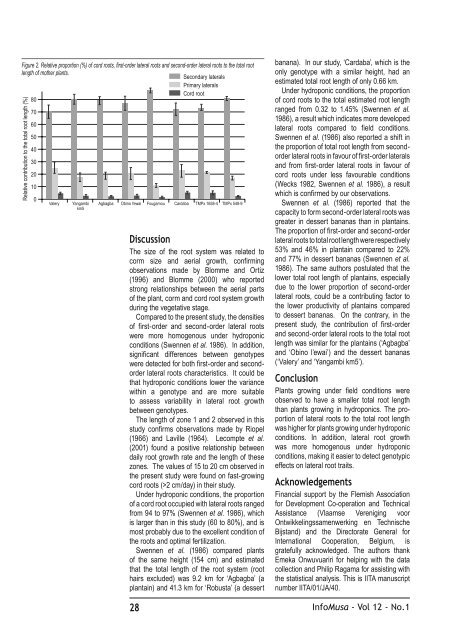Château-Musa - Bioversity International
Château-Musa - Bioversity International
Château-Musa - Bioversity International
Create successful ePaper yourself
Turn your PDF publications into a flip-book with our unique Google optimized e-Paper software.
Figure 2. Relative proportion (%) of cord roots, first-order lateral roots and second-order lateral roots to the total root<br />
length of mother plants.<br />
Secondary laterals<br />
Primary laterals<br />
Cord root<br />
80<br />
Relative contribution to the total root length (%)<br />
70<br />
60<br />
50<br />
40<br />
30<br />
20<br />
10<br />
0<br />
Valery Yangambi<br />
km5<br />
Agbagba Obino l'ewai Fougamou Cardaba TMPx 1658-4 TMPx 548-9<br />
Discussion<br />
The size of the root system was related to<br />
corm size and aerial growth, confirming<br />
observations made by Blomme and Ortiz<br />
(1996) and Blomme (2000) who reported<br />
strong relationships between the aerial parts<br />
of the plant, corm and cord root system growth<br />
during the vegetative stage.<br />
Compared to the present study, the densities<br />
of first-order and second-order lateral roots<br />
were more homogenous under hydroponic<br />
conditions (Swennen et al. 1986). In addition,<br />
significant differences between genotypes<br />
were detected for both first-order and secondorder<br />
lateral roots characteristics. It could be<br />
that hydroponic conditions lower the variance<br />
within a genotype and are more suitable<br />
to assess variability in lateral root growth<br />
between genotypes.<br />
The length of zone 1 and 2 observed in this<br />
study confirms observations made by Riopel<br />
(1966) and Laville (1964). Lecompte et al.<br />
(2001) found a positive relationship between<br />
daily root growth rate and the length of these<br />
zones. The values of 15 to 20 cm observed in<br />
the present study were found on fast-growing<br />
cord roots (>2 cm/day) in their study.<br />
Under hydroponic conditions, the proportion<br />
of a cord root occupied with lateral roots ranged<br />
from 94 to 97% (Swennen et al. 1986), which<br />
is larger than in this study (60 to 80%), and is<br />
most probably due to the excellent condition of<br />
the roots and optimal fertilization.<br />
Swennen et al. (1986) compared plants<br />
of the same height (154 cm) and estimated<br />
that the total length of the root system (root<br />
hairs excluded) was 9.2 km for ‘Agbagba’ (a<br />
plantain) and 41.3 km for ‘Robusta’ (a dessert<br />
28<br />
banana). In our study, ‘Cardaba’, which is the<br />
only genotype with a similar height, had an<br />
estimated total root length of only 0.66 km.<br />
Under hydroponic conditions, the proportion<br />
of cord roots to the total estimated root length<br />
ranged from 0.32 to 1.45% (Swennen et al.<br />
1986), a result which indicates more developed<br />
lateral roots compared to field conditions.<br />
Swennen et al. (1986) also reported a shift in<br />
the proportion of total root length from secondorder<br />
lateral roots in favour of first-order laterals<br />
and from first-order lateral roots in favour of<br />
cord roots under less favourable conditions<br />
(Wecks 1982, Swennen et al. 1986), a result<br />
which is confirmed by our observations.<br />
Swennen et al. (1986) reported that the<br />
capacity to form second-order lateral roots was<br />
greater in dessert bananas than in plantains.<br />
The proportion of first-order and second-order<br />
lateral roots to total root length were respectively<br />
53% and 46% in plantain compared to 22%<br />
and 77% in dessert bananas (Swennen et al.<br />
1986). The same authors postulated that the<br />
lower total root length of plantains, especially<br />
due to the lower proportion of second-order<br />
lateral roots, could be a contributing factor to<br />
the lower productivity of plantains compared<br />
to dessert bananas. On the contrary, in the<br />
present study, the contribution of first-order<br />
and second-order lateral roots to the total root<br />
length was similar for the plantains (‘Agbagba’<br />
and ‘Obino l’ewai’) and the dessert bananas<br />
(‘Valery’ and ‘Yangambi km5’).<br />
Conclusion<br />
Plants growing under field conditions were<br />
observed to have a smaller total root length<br />
than plants growing in hydroponics. The proportion<br />
of lateral roots to the total root length<br />
was higher for plants growing under hydroponic<br />
conditions. In addition, lateral root growth<br />
was more homogenous under hydroponic<br />
conditions, making it easier to detect genotypic<br />
effects on lateral root traits.<br />
Acknowledgements<br />
Financial support by the Flemish Association<br />
for Development Co-operation and Technical<br />
Assistance (Vlaamse Vereniging voor<br />
Ontwikkelingssamenwerking en Technische<br />
Bijstand) and the Directorate General for<br />
<strong>International</strong> Cooperation, Belgium, is<br />
gratefully acknowledged. The authors thank<br />
Emeka Onwuvuariri for helping with the data<br />
collection and Philip Ragama for assisting with<br />
the statistical analysis. This is IITA manuscript<br />
number IITA/01/JA/40.<br />
Info<strong>Musa</strong> - Vol 12 - No.1

















